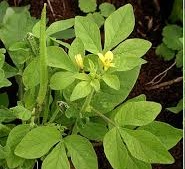Comparison of the antioxidant activity and total phenolic, flavonoid content of aerial part of Cleome viscosa L.
Keywords:
Cleome viscosa, total phenolic and flavonoid content, β carotene bleaching assay, reducing power, free radical scavenging activityAbstract
Cleome viscosa L. (Capparidaceae), commonly known as “wild mustard”, is an annual, sticky herb found as common weed all over the plains of India and throughout the tropics of the world. In traditional systems of medicine the plant is reported to possess beneficial effects as an anthelmintic, antiseptic, carminative, antiscorbutic, febrifuge, and cardiac stimulant. The aim of the present study was to evaluate the antioxidant activity of 70% methnolic extract of leaf and stem part of Cleome viscosa (CV) by using different in vitro model such as β carotene bleaching assay, reducing power and free radical scavenging activity (DPPH and hydroxyl radical scavenging activity). Total phenolic content were estimated by the Folin–Ciocalteu colorimetric method using gallic acid as standard and expressed as mg/g gallic acid equivalent (GAE) and total flavonoid content was estimated by aluminium chloride colourimetric method. The total phenolic, flavonoid content and antioxidant activity of Cleome viscosa leaves were found to be 66.38±0.82mg/g, 0.54±0.04mg/g and 77.30% respectively. Cleome viscosa leaves showed high free radical scavenging activity as evidenced by the low IC50 values in both DPPH (1,1-diphenyl-2-picryl hydrazyl) (373.18 μg/ml) and hydroxyl radical (573.55 μg/ml) methods. Cleome viscosa leaves possess high phenolic, flavonoid content and potential antioxidant activity, reducing power and free radical scavenging activity in comparison to stem.
References
. Rice Evans C. Flavonoids and
isoflavones: absorption,metabolism and
bioactivity. Free Rad. Biol. Med. 2004;
: 827-828.
. Prior RL, Wu X, Schaich K. Standardized
methods for the determination of
antioxidant capacity and phenolics in
foods and dietary supplements. J. Agric.
Food Chem. 2005; 53: 4290-4302.
. Mathew S, Abraham TE. In vitro
antioxidant activity and scavenging
effects of Cinnamomum verum leaf
extract assayed by different
methodologies. Food Chem Toxicol.
; 44: 198-206.
. Ito N, Fukushima S, Hagiwara A, Shibata
M, Ogiso T. Carcinogenicity of butylated
hydroxyanisole in F344 rats. J.
Natl.Cancer Inst. 1983; 70: 343-347.
. Gao JJ, Igalashi K, Nukina M. Radical
scavenging activity of phenylpropanoid
glycosides in Caryopteris incana.
Biosci.Biotechnol. Biochem. 1999; 63:
-988.
. Nadkarni AK. The Indian material
medica. vol. I. Poular prakashan:
Bombay; 1994. p. 351-352.
. Chatterjee A, Pakrashi S.C. The Treatise
on Indian Medicinal Plants PID. Council
for Scientific and Industrial research: New
Delhi; 1991. p. 155.
. Anonymous: The Wealth of India. Vol. I.
Publication and Information Directorate,
CSIR: New Delhi; 1966. p. 231.
. Kirtikar KR, Basu BD. Indian Medicinal
Plants. In: Bisen Singh and Mahendra Pal
Singh. 2nd ed. Dehradun; 1975. p. 183-
. Mandal SC, Mukhaerjee PK, Saha K, Pal
M, Saha BP. Studies on analgesic activity
of Cleome viscoa in mice. Fitoterapia
74:262-266.
. Parimala Devi B, Boominathan R,
Mandal SC. Evaluation of anti-diarrheal
activity of Cleome viscosa extract in rats.
Phytomedicine 2002. 9:739-742.
. Boominathan R, Mandal SC, Parimala
Devi B. Evaluation of antipyretic
potential of Cleome viscosa extract in rats.
J of Ethnopharmacol. 2003;87:11-13.
. Parimala Devi B, Boominathan R,
Mandal SC. Studies on
psychopharmacological effects of Cleome
viscosa Linn. extract in rats and mice.
Phytother Res. 2004;18:169-72.
. Sudhakar M, Rao ChV, Raju DB.
Evaluation of antimicrobial activity of
Cleome viscose and Gmelina asiatica.
Fitoterapia. 2006;77(1):47-49.
. Mahady GB, Bhamarapravati S, Adeniyi
BA, Pendland SL, Doyle B, Locklear T,
Solver C. Traditional Thai Medicines
inhibit Helicobacter pylori in vitro and in
vivo: Support for ethnomedical use.
Ethnobotany research and Applications.
;4:159-165.
. Ragazzi E, Veronese G. Quantitative
analysis of phenolic compounds after
thin-layer chromatographic separation. J
Chromatography. 1973;77:369-375.
. Woisky R, Salatino A. Analysis of
Propils: Some parameters and procedure
for chemical quality control. Journal of
Agricultural Res. 1998;37:99-105.
. Rekha PS, Girija K, Ramadasan K.
Antioxidant activity of Brahma rasayana.
Indian Journal of Experimental Biology.
;39:447–452.
. Emmons CL, Peterson DM, Antioxidant
Activity and Phenolic Contents of Oat
Groats and Hulls. Cereal Chem.
;76(6):902-906.
. Apati P, Szentmihalyi K, Kristo SZT,
Papp I., Vinkler P, Szoke E, Kery A.
Herbal remedies of Solidago—correlation
of phytochemical characteristics and
antioxidative properties. J Pharma
Biomed. Anal. 2003;32:1045–1053.
. Yen GC, Duh PD. Scavenging Effect of
Methanolic Extracts of Peanut Hulls on
Free-Radical and Active-Oxygen Species.
J Agri Food Chem. 1994;42:629 –632.
. Kroyer GTh, Red clover extract as
antioxidant active and functional food
ingredient. Innovative Food Sci Emer
Tech. 2004;5:101-105.
. Pokorny J, Yanishlieva N, Gordan M.
Antioxidants in food: Practical
applications. Woodhead Publishing
Limited: Cambridge; 2001.
. Pitchaon M, Suttajit M, Pongswatmani R.
Assessment of phenolic content and free
radical scavenging capacity of some thai
indigenous plants. Food chemistry.
;4:1409-1418.
. Yen GC, Chen HY. Antioxidant activity
of various tea extracts in relation to their
antimutagenecity. Journal of Agriculture
and Food Chemistry. 1995;43:7-32.



